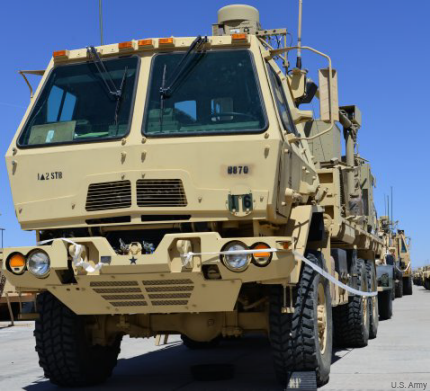Joint forces, 13 countries test ability to work together
The Joint Staff’s “Bold Quest” exercise puts interoperable tactical communications to the test.

An FMTV will carrying the Tactical Communications Node during exercises at Fort Bliss.
The U.S. military’s joint battlefield communications system is being put to the test this week in the latest “Bold Quest” exercise involving joint U.S. forces and a baker’s dozen of allied nations.
Let by the Joint Staff, drills are being held at White Sands Missile Range, N.M. — with related activities at Fort Bliss, Texas, and Holloman Air Force Base, N.M. — to evaluate new technologies and work on improving access and interoperability, the Defense Department said. Radios, tactical data links and networking equipment for air and ground forces are among the technologies being tested.
Past Bold Quest events, now in their 11th year, were aimed at operational needs of forces in Iraq and Afghanistan. This year’s exercise is looking to maximize resource and information sharing, and find out where shortcomings exist. Participants include the four U.S. military services, the National Guard, U.S. Special Operations Command and participants or observers from Australia, Belgium, Canada, Denmark, Finland, France, Germany, Italy, the Netherlands, Norway, Poland, Sweden and Britain, DOD said. The event got started May 16 and will run through May 23.
At Fort Bliss, the Army also is integrating Bold Quest with its Network Integration Evaluation 14.2, the latest in a series of exercises that tests its battlefield network. The Army traditionally has held NIEs on its own, but saw an opportunity to combine NIE 14.2 with Bold Quest in a way that is both beneficial and cost-effective, officials said.
"The NIE has always been about the Army tactical network, and we've worked very hard so we can talk to each other," Lt. Gen. Keith C. Walker, deputy commanding general of Futures for the U.S. Army Training and Doctrine Command, said during preparations for the event. "But the reality is, we don't fight alone as an Army. We fight as a joint force with our Air Force, Navy and Marine Corps partners. In fact, we fight as a combined force with our coalition partners."
In addition to working with coalition forces, Walker said NIE 14.2 also will focus on working more closely with industry partners that supply equipment and services for the tactical network. Soldier feedback is a key element in NIEs, helping Army leaders identify communications and interoperability gaps and recognize where systems need to be improved. The Army plans to let industry representatives meet with soldiers early on and get that feedback directly.
As with Bold Quest, the latest NIE is reflecting the changes inherent from drawdown in Afghanistan and shift in focus to the Pacific.



